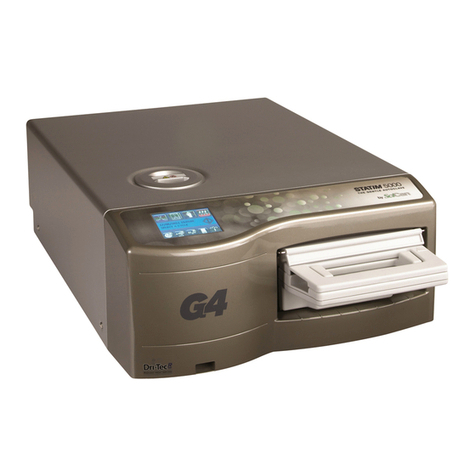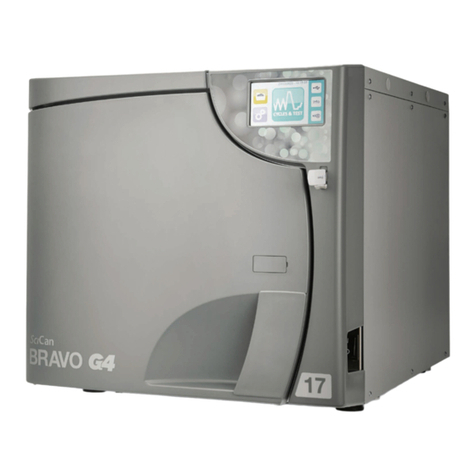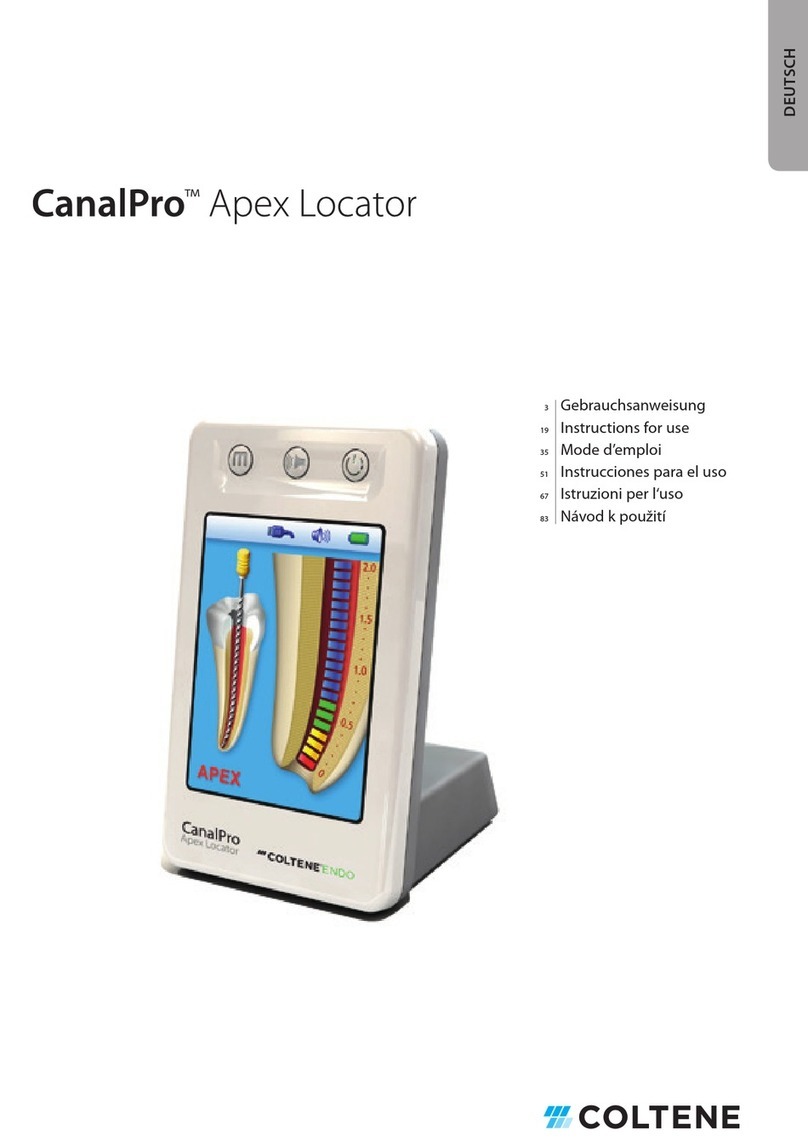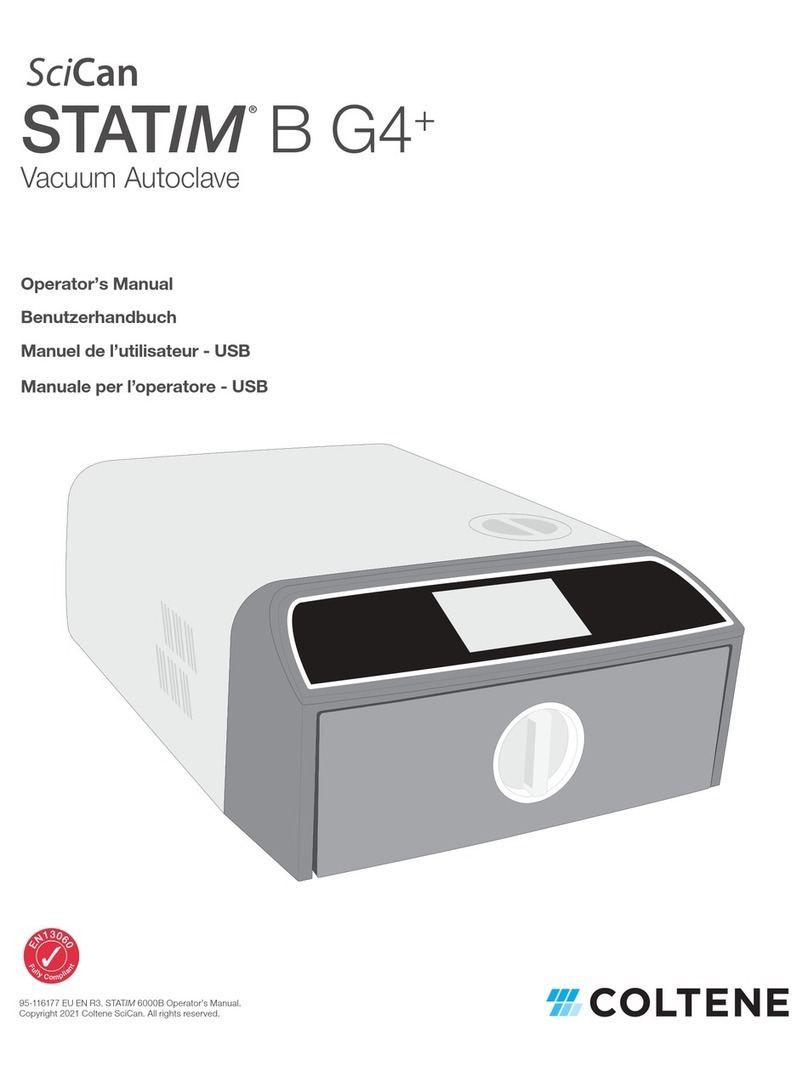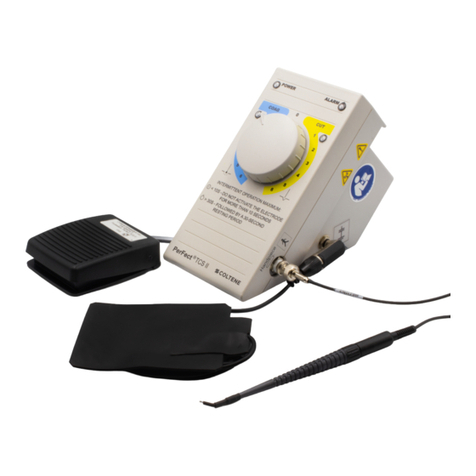
Owner’s Guide 5
EN
NOTE: A warbling sound indicates that the dispersive
electrode is not connected or is defective. In this situation,
the unit is automatically deactivated and will not operate.
Verify the dispersive electrode connector is fully inserted. If
it is, the dispersive electrode may be defective and should be
replaced. If the replacement does not correct the situation,
the unit requires servicing.
When the procedure has been completed, remove the electrode
from tissue and deactivate the footswitch. Rotate the intensity
control to the center “0” position and unscrew the electrode sheath
from the handpiece cord assembly for sterilization.
Please Note: In compliance with IEC 60601-2-2, requirements for
the safety of high frequency surgical equipment, this unit generates
an audible tone when operated.
Preoperative practice
This guide is not intended to be a substitute for formal instruction.
The new user of electrosurgery is strongly urged to undertake
adequate study before performing clinical operative procedures.
After receiving instruction, practicing on raw, lean beef can help
the practitioner acquire the necessary dexterity to achieve superior
clinical results. Select a piece of fresh, lean beef (round steak or shin
beef) and allow to reach room temperature.
Cutting practice
1. Place the meat on the dispersive electrode.
2. Thread the Straight Knife electrode sheath onto the handpiece
swivel connector.
3. With the power switch “On,” rotate the Intensity Control to
position “1” in the Cut mode (to the right).
4. Depress the footswitch to activate the electrode.
5. Using a smooth, rapid, brush-like motion, make several incisions
of varying length and depth (Figure4). You may nd it helpful
to use a nger rest to achieve precise control. Observe that the
electrode either fails to cut or does so only with considerable
dragging. Note also that cutting, if it occurs, causes tissue shreds
to adhere to the electrode tip.
6. Repeat the procedure above at successively higher intensity
settings. If the electrode encounters appreciable resistance, the
setting is too low. Increase the setting until there is no resistance
to cutting and there is no sparking and no discoloration along
the incision. This point is the lowest effective intensity setting for
a practice procedure. Allow 10–15 seconds for the tissue to cool
before cutting again in the same area.
7. Increase the intensity setting one position above that which
provided optimum results. Observe sparking and discoloration
in the form of charring and tissue blanching along the
cutting track.
Continue to practice a variety of incisions using different electrodes
and with the intensity setting at different levels. Observe the cutting
results and the action of the electrode tip when settings are too low,
too high, or correct. For best results, use the lowest effective output
intensity; this is the proper setting for most procedures.
Coagulation practice
With a little practice, coagulation is easily achieved with the
PerFect TCS II. Use the same specimen of lean beef on the dispersive
electrode. Simulation of effective coagulation is achieved when the
treated area shows a blanched spot of approximately 2mm or less
in diameter.
1. Insert the Coag Ball electrode and rotate the Output Control to
position “1” on the Coag scale (to the left).
2. Activate the electrode and, with a dabbing motion, place the
ball tip in light contact with the specimen, maintaining contact
for approximately 1 second. Allow 10–15 seconds for the tissue
to cool and repeat the procedure until a blanched spot indicates
that coagulation is achieved.
3. Repeat this technique at successively higher output intensity
settings until blanching occurs after one or two applications of
the electrode: this is the proper setting for most coagulation
procedures.
4. Also practice coagulating with the Straight Knife electrode, which
is particularly useful in hard to reach areas. However, since the
Straight Knife electrode focuses energy in a smaller area, the
intensity setting should be lower than that used with the Coag
Ball electrode.
General principles of electrosurgery technique
The following guidelines will help you benet from the advantages
of electrosurgery. For additional important information, please refer
to the Special Notes and Precautions section.
Placement of equipment
It’s important to place the PerFect TCS II unit so that the controls,
handpiece, electrodes, and accessories are readily accessible for use
with a minimum of motion and wasted time. The unit should be
plugged in at all times and the console should be within arm’s reach
of the operator. All of the functions, controls and settings should be
controlled by the dentist.
The dispersive electrode
The dispersive electrode ensures that the energy ow from the small,
active electrode is predictable and uniform. It must be used during
all electrosurgical procedures. The entire area of the dispersive
electrode should be placed in rm, nonconductive contact with the
patient, preferably against the patient’s upper back, contacting the
maximum possible area.
WARNING
To reduce the risk of accidental RF burns, do not
place the dispersive electrode in contact with
bare skin. Hand-held or hand-worn dispersive
electrodes should not be used.
The patient, operator or assistant should not
come into contact with metal parts, such as
metal arm rests of chairs. Use only non-con-
ducting (plastic) instruments (mirror, retractor,
saliva evacuation tube, etc.) when performing
procedures.
The cutting stroke
Your cutting stroke should be smooth, rapid and brush-like. Before
each cut, you may nd it helpful to try several practice strokes with
an inactive electrode, much as a golfer takes practice strokes before
putting. This will help you assume a comfortable grasp on the
handpiece and will enable you to plan the position and length of
the actual cutting stroke. Remember to use the lowest effective
output setting for best results. When cutting, use several short
strokes rather than a single long stroke. Rather than commit to a
single irreversible cut (as you must do with a scalpel), you may nd
it preferable to shave tissue in very ne layers to achieve a more
precise, aesthetically pleasing result. Cutting precision can also be
enhanced by using a nger or hand rest to steady your stroke.






